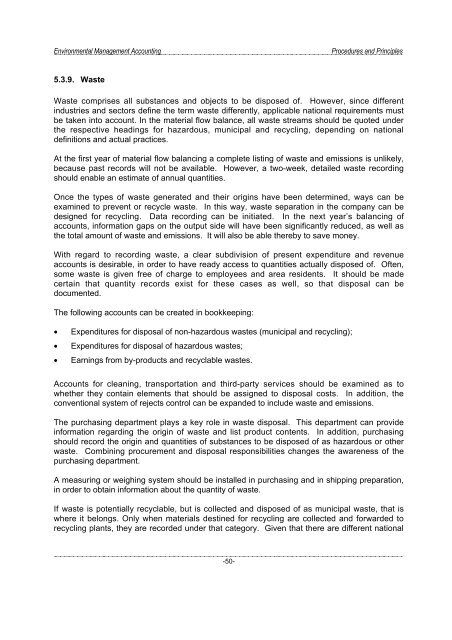Environmental Management Accounting Procedures and Principles
Environmental Management Accounting Procedures and Principles
Environmental Management Accounting Procedures and Principles
Create successful ePaper yourself
Turn your PDF publications into a flip-book with our unique Google optimized e-Paper software.
<strong>Environmental</strong> <strong>Management</strong> <strong>Accounting</strong><br />
<strong>Procedures</strong> <strong>and</strong> <strong>Principles</strong><br />
5.3.9. Waste<br />
Waste comprises all substances <strong>and</strong> objects to be disposed of. However, since different<br />
industries <strong>and</strong> sectors define the term waste differently, applicable national requirements must<br />
be taken into account. In the material flow balance, all waste streams should be quoted under<br />
the respective headings for hazardous, municipal <strong>and</strong> recycling, depending on national<br />
definitions <strong>and</strong> actual practices.<br />
At the first year of material flow balancing a complete listing of waste <strong>and</strong> emissions is unlikely,<br />
because past records will not be available. However, a two-week, detailed waste recording<br />
should enable an estimate of annual quantities.<br />
Once the types of waste generated <strong>and</strong> their origins have been determined, ways can be<br />
examined to prevent or recycle waste. In this way, waste separation in the company can be<br />
designed for recycling. Data recording can be initiated. In the next year’s balancing of<br />
accounts, information gaps on the output side will have been significantly reduced, as well as<br />
the total amount of waste <strong>and</strong> emissions. It will also be able thereby to save money.<br />
With regard to recording waste, a clear subdivision of present expenditure <strong>and</strong> revenue<br />
accounts is desirable, in order to have ready access to quantities actually disposed of. Often,<br />
some waste is given free of charge to employees <strong>and</strong> area residents. It should be made<br />
certain that quantity records exist for these cases as well, so that disposal can be<br />
documented.<br />
The following accounts can be created in bookkeeping:<br />
• Expenditures for disposal of non-hazardous wastes (municipal <strong>and</strong> recycling);<br />
• Expenditures for disposal of hazardous wastes;<br />
• Earnings from by-products <strong>and</strong> recyclable wastes.<br />
Accounts for cleaning, transportation <strong>and</strong> third-party services should be examined as to<br />
whether they contain elements that should be assigned to disposal costs. In addition, the<br />
conventional system of rejects control can be exp<strong>and</strong>ed to include waste <strong>and</strong> emissions.<br />
The purchasing department plays a key role in waste disposal. This department can provide<br />
information regarding the origin of waste <strong>and</strong> list product contents. In addition, purchasing<br />
should record the origin <strong>and</strong> quantities of substances to be disposed of as hazardous or other<br />
waste. Combining procurement <strong>and</strong> disposal responsibilities changes the awareness of the<br />
purchasing department.<br />
A measuring or weighing system should be installed in purchasing <strong>and</strong> in shipping preparation,<br />
in order to obtain information about the quantity of waste.<br />
If waste is potentially recyclable, but is collected <strong>and</strong> disposed of as municipal waste, that is<br />
where it belongs. Only when materials destined for recycling are collected <strong>and</strong> forwarded to<br />
recycling plants, they are recorded under that category. Given that there are different national<br />
-50-




